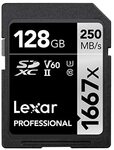This seemed like an ok price for a 128gb UHS II SDXC.
Delivery without prime $7.10. Fulfilled by Amazon UK.
Description from Amazon:
Description
Whether you’re a professional photographer, videographer, or enthusiast, Lexar Professional 1667x SDXC UHS-II card Make it easy to quickly capture and transfer 1080P full-HD, 3D, and 4K video. This card leverages UHS-II technology (UHS Speed Class 3 (U3)) to deliver high-speed performance—up to 250MB/s (1667x). this dramatically accelerates workflow from start to finish. For versatility, this card also works with UHS-I devices at UHS-I speeds, and they’re backwards compatible with older cameras and readers, performing at class 10 speeds when used with non-UHS devices. Card also come with a limited lifetime warranty.
Features & details
Get high speed performance with UHS II technology (U3) for a read transfer speed up to 250MB/s (1667x), up to 120MB/s write
Captures high quality images and extended lengths of stunning 1080P full HD, 3D, and 4K video with a DSLR camera, HD camcorder, or 3D Camera
Large capacity options up to 256GB let you enjoy shooting longer without changing cards
High speed file transfer from card to computer to dramatically accelerate workflow
Backwards compatible with UHS I devices.Limited lifetime



 CamelCamelCamel
CamelCamelCamel

For most people, its not.
There are shockingly few devices with the extra contacts required to use advanced uhs speeds.
Much better with 'high endurance' from any brand, or just samsung cards, where the write speed is steady (and fast) unless you know you have a special UHS device.
Just an fyi for the less nerdy.